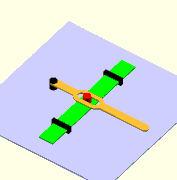Rectilinear Motion of Particles - Meaning, Example, Types, FAQs
What is meant by rectilinear motion? or Define rectilinear motion. or Rectilinear motion definition.
Rectilinear meaning: The body is in motion when the position of an object varies with respect to time and its surroundings. Motion can be defined mathematically using displacement, velocity, and acceleration in a specific frame of reference. A particle's motion can be classed based on its trajectory, with the rectilinear motion of a particle being the most basic. The vectors of displacement, velocity, and acceleration are limited to one dimension.

Rectilinear (or linear) motion is defined as a particle's movement constrained to a straight line. Only one coordinate can be used to describe such a motion. The particle's displacement, as well as its derivatives, such as velocity and acceleration, are all one-dimensional vectors. A car going along a straight path in free fall under the gravitational field of the Earth can be modeled as a rectilinear motion of a particles
Also read -
Example of rectilinear motion of a particle-
- Free fall under gravity and the simple harmonic motion of a mass linked to a spring are examples of the rectilinear motion of a particle.
- Elevators are an example of rectilinear motion is of rectilinear mobility in public areas.
- Rectilinear motion is caused by gravitational forces acting on objects, culminating in free fall.
- The motion of children sliding down a slide is rectilinear.
- Planes in the sky move in a rectilinear pattern.
Types of rectilinear motion-
There are three different types of rectilinear motion:
- Uniform rectilinear motion occurs when an item moves at a constant speed with no acceleration.
- Uniformly accelerated rectilinear motion occurs when an object moves with a consistent rate of acceleration.
- Rectilinear movement with non-uniform acceleration: A rectilinear movement with non-uniform acceleration occurs when an object moves at an uneven speed and acceleration.
Characteristics of rectilinear motions-
- It follows a straight-line path.
- It lacks normal (centripetal) acceleration, which, as you may recall, is what causes the motion to shift direction.
What is linear motion?
Linear motion is one-dimensional motion in a straight line that can be mathematically described with only one spatial dimension.
Linear motion example- Linear motion is demonstrated by a ball tossed straight up and falling straight down.

Mathematical form of motion-
A one-dimensional reference frame with an axis (X-axis) and an origin at O (x = 0) is used to qualitatively evaluate rectilinear motion.
Position, distance, and displacement:
A particle's position is a vector quantity that is measured from the origin to the particle. The distance between them determines its magnitude. When you set a particle in motion, it follows a route that changes its position over time. Displacement is the vector difference in position after a time interval, pointing from the initial to the final location. The overall path covered along the trajectory is measured in distance, whereas the shortest path is measured in displacement. The displacement is provided by, if the particle's position moves from xi to xf in time t.
x=xf−xi
Speed and velocity-
The temporal rate of change of displacement is termed velocity, while the rate of change of distance is called speed. While speed is a scalar, velocity is a vector with the same direction as displacement. At time t, the instantaneous velocity is given by,
$$
\mathrm{V}=\mathrm{d} x / \mathrm{dt}
$$
Acceleration-
The time rate of change is defined as acceleration when velocity changes over time. It's a vector, too.
$$
\mathrm{A}=\mathrm{dv} / \mathrm{dt}=\mathrm{d}^{\wedge} 2 \mathrm{x} / \mathrm{dt} \mathrm{t}^{\wedge} 2
$$
Because all vectors are confined to one dimension, only the magnitudes need to be considered.
Also, check-
- NCERT Exemplar Class 11th Physics Solutions
- NCERT Exemplar Class 12th Physics Solutions
- NCERT Exemplar Solutions for All Subjects
NCERT Physics Notes:
Frequently Asked Questions (FAQs)
There are three types of rectilinear motion:
The motion of a body with zero acceleration is known as uniform motion. There is no net force operating on the body.
Uniformly accelerated motion is defined as motion with a non-zero constant acceleration and a constant net force on the system.
Non-uniform acceleration motion. The system is subjected to a variable force.
Linear motion is an object's natural motion: it moves in a straight path. Newton's First Law of Motion states that an item that is not affected by any force will continue in a straight line eternally.
In everyday life, there are many examples of linear motion, such as when an athlete runs on a straight track. Linear motion is used on a regular basis. A car travelling down a straight road is an illustration of this. Cars, in fact, alternate between linear and circular motion all the time.
Rectilinear motion describes the movement of an object in a straight line. A train on a track, a parade, and coins hurled in the air are all examples of rectilinear motion. The motion of an object that moves at a given distance from a fixed point is known as circular motion. All of the objects in this scene rotate in a circular manner.